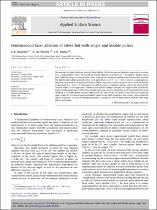JavaScript is disabled for your browser. Some features of this site may not work without it.
- ResearchSpace
- →
- Research Publications/Outputs
- →
- Journal Articles
- →
- View Item
| dc.contributor.author |
Roberts, DE

|
|
| dc.contributor.author |
Du Plessis, A

|
|
| dc.contributor.author |
Botha, LR

|
|
| dc.date.accessioned | 2010-08-20T10:16:52Z | |
| dc.date.available | 2010-08-20T10:16:52Z | |
| dc.date.issued | 2009 | |
| dc.identifier.citation | Roberts, DE, Du Plessis, A and Botha, LR. 2009. Femtosecond laser ablation of silver foil with single and double pulses. Applied Surface Science, Vol 256(6), pp 1784-1792 | en |
| dc.identifier.issn | 0169-4332 | |
| dc.identifier.uri | http://www.sciencedirect.com/science?_ob=MImg&_imagekey=B6THY-4XDMHBS-6-W&_cdi=5295&_user=958262&_pii=S0169433209014202&_orig=search&_coverDate=01/01/2010&_sk=997439993&view=c&wchp=dGLzVlz-zSkzk&md5=b7a2a0168cc33a93f6cb02e9e35b2265&ie=/sdarticle.pdf | |
| dc.identifier.uri | http://hdl.handle.net/10204/4181 | |
| dc.description | Copyright: 2009 Elsevier. This is the post-print version. The definitive version is published in the Applied Surface Science Journal, Vol 256(6), pp 1784-1792 | en |
| dc.description.abstract | The average ablation depth per pulse of silver foil by 130 fs laser pulses has been measured in vacuum over a range of three orders of magnitude of pulse fluence up to 900 J cm_2. In addition, double pulses with separations up to 3.4 ns have been used to probe time scales of relevance for femtosecond ablation. The double pulse ablation depth, when each pulse fluence is 0.7 J cm_2, falls to that of a single pulse as the pulse separation is increased from 0 ps to 700 ps. This time scale decreases to only 4 ps as the fluence is increased to 11 J cm_2. It then jumps to 500 ps across a transition fluence where the slope of the ablation depth versus logarithmic fluence characteristic changes abruptly to a higher value. In addition, for pulse separations near 1000 ps, the second pulse can cause re-deposition of ejecta from the first pulse resulting in a double pulse ablation depth only 40% that of the first pulse alone. This has important implications for the interpretation of double pulse femto-LIBS intensities. Our results suggest that the optical properties of nano or mesoparticles play a significant role in double pulse ablation with large pulse separations | en |
| dc.language.iso | en | en |
| dc.publisher | Elsevier | en |
| dc.subject | Femtosecond metal ablation | en |
| dc.subject | Double pulse ablation | en |
| dc.subject | Nanoparticle deposition | en |
| dc.subject | Femto-LIBS | en |
| dc.subject | Silver nanoparticles | en |
| dc.title | Femtosecond laser ablation of silver foil with single and double pulses | en |
| dc.type | Article | en |
| dc.identifier.apacitation | Roberts, D., Du Plessis, A., & Botha, L. (2009). Femtosecond laser ablation of silver foil with single and double pulses. http://hdl.handle.net/10204/4181 | en_ZA |
| dc.identifier.chicagocitation | Roberts, DE, A Du Plessis, and LR Botha "Femtosecond laser ablation of silver foil with single and double pulses." (2009) http://hdl.handle.net/10204/4181 | en_ZA |
| dc.identifier.vancouvercitation | Roberts D, Du Plessis A, Botha L. Femtosecond laser ablation of silver foil with single and double pulses. 2009; http://hdl.handle.net/10204/4181. | en_ZA |
| dc.identifier.ris | TY - Article AU - Roberts, DE AU - Du Plessis, A AU - Botha, LR AB - The average ablation depth per pulse of silver foil by 130 fs laser pulses has been measured in vacuum over a range of three orders of magnitude of pulse fluence up to 900 J cm_2. In addition, double pulses with separations up to 3.4 ns have been used to probe time scales of relevance for femtosecond ablation. The double pulse ablation depth, when each pulse fluence is 0.7 J cm_2, falls to that of a single pulse as the pulse separation is increased from 0 ps to 700 ps. This time scale decreases to only 4 ps as the fluence is increased to 11 J cm_2. It then jumps to 500 ps across a transition fluence where the slope of the ablation depth versus logarithmic fluence characteristic changes abruptly to a higher value. In addition, for pulse separations near 1000 ps, the second pulse can cause re-deposition of ejecta from the first pulse resulting in a double pulse ablation depth only 40% that of the first pulse alone. This has important implications for the interpretation of double pulse femto-LIBS intensities. Our results suggest that the optical properties of nano or mesoparticles play a significant role in double pulse ablation with large pulse separations DA - 2009 DB - ResearchSpace DP - CSIR KW - Femtosecond metal ablation KW - Double pulse ablation KW - Nanoparticle deposition KW - Femto-LIBS KW - Silver nanoparticles LK - https://researchspace.csir.co.za PY - 2009 SM - 0169-4332 T1 - Femtosecond laser ablation of silver foil with single and double pulses TI - Femtosecond laser ablation of silver foil with single and double pulses UR - http://hdl.handle.net/10204/4181 ER - | en_ZA |






